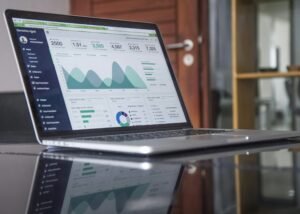Top 5 uses of Excel
Data Analysis: Excel is widely used for organizing, analyzing, and visualizing data. It offers various tools and functions for sorting, filtering, and summarizing large datasets, making it invaluable for data analysis tasks.
- Data Cleaning and Preparation: Excel provides various tools and functions for cleaning and preparing data for analysis. Users can remove duplicates, correct errors, and format data to ensure its accuracy and consistency before analysis.
- Descriptive Statistics: Excel offers a wide range of statistical functions for calculating descriptive statistics such as mean, median, mode, standard deviation, and variance. These functions help users summarize and understand the characteristics of their data.
- Data Visualization: Excel allows users to create visual representations of data using charts and graphs. Users can choose from a variety of chart types, including bar charts, line charts, pie charts, and scatter plots, to effectively communicate insights from their data.
- PivotTables and PivotCharts: Excel’s PivotTable and PivotChart features are powerful tools for summarizing and analyzing large datasets. Users can quickly rearrange and summarize data, perform calculations, and create interactive visualizations to explore trends and patterns in their data.
- Regression Analysis: Excel supports regression analysis, a statistical technique used to model the relationship between two or more variables. Users can use Excel’s regression analysis tools to fit linear and nonlinear regression models to their data, analyze relationships between variables, and make predictions based on the model.

Financial Modeling Excel is a powerful tool for creating financial models, budgeting, forecasting, and performing financial analysis. It allows users to build complex formulas and perform calculations to analyze financial data efficiently.
- Forecasting and Budgeting: Excel allows users to create financial models to forecast future financial performance and plan budgets. Users can build dynamic models that incorporate historical data, assumptions, and projections to estimate revenues, expenses, cash flows, and other financial metrics.
- Valuation Analysis: Excel is used for conducting valuation analysis to determine the intrinsic value of assets, companies, or investments. Users can build discounted cash flow (DCF) models, comparable company analysis (CCA), and other valuation models to assess the worth of investments and make informed decisions.
- Scenario Analysis and Sensitivity Analysis: Excel enables users to perform scenario analysis and sensitivity analysis to evaluate the impact of different variables and assumptions on financial outcomes. Users can create multiple scenarios and assess how changes in factors such as revenue growth, costs, interest rates, and market conditions affect financial performance.
- Financial Statement Modeling: Excel is used to create financial statement models, including income statements, balance sheets, and cash flow statements. Users can build interconnected models that link financial statements and reflect the relationships between different financial metrics.
- Investment Analysis: Excel is employed for analyzing investment opportunities and making investment decisions. Users can build investment models to assess the potential returns, risks, and feasibility of investment projects, assets, or securities. Excel’s functions and tools enable users to calculate key investment metrics such as internal rate of return (IRR), net present value (NPV), and return on investment (ROI).

Reporting and Dashboards: Excel is commonly used for creating reports and interactive dashboards. Users can design visually appealing charts, graphs, and tables to present data insights effectively to stakeholders.
- Data Consolidation: Excel can consolidate data from multiple sources into a single spreadsheet or workbook. Users can use functions like VLOOKUP, INDEX-MATCH, or Power Query to merge and organize data from different sources, making it easier to analyze and report on.
- PivotTables: Excel’s PivotTable feature allows users to summarize and analyze large datasets quickly. Users can create PivotTables to summarize data by categories, perform calculations, and generate aggregated reports with interactive filtering and sorting options.
- Charts and Graphs: Excel offers a variety of chart types to visualize data trends and patterns. Users can create bar charts, line charts, pie charts, and more to present data in a visually appealing and understandable format within reports and dashboards.
- Interactive Dashboards: Excel allows users to create interactive dashboards that consolidate key metrics and insights from multiple datasets. Users can design dashboards with charts, graphs, tables, and slicers to provide an overview of data trends and enable users to explore data interactively.
- Conditional Formatting: Excel’s Conditional Formatting feature enables users to apply visual formatting rules to cells based on their values. Users can use conditional formatting to highlight important data points, identify trends, or visualize data distributions within reports and dashboards

Project Management: Excel can be used for project planning, tracking progress, and managing tasks and resources. It offers features such as Gantt charts, timelines, and project scheduling templates to help users organize and manage projects efficiently.
- Gantt Charts: Excel allows users to create Gantt charts, which visualize project schedules by displaying tasks, milestones, and dependencies over time. Users can use Excel’s built-in bar chart features or utilize templates to create Gantt charts that illustrate project timelines and progress.
- Task Tracking: Excel can be used to track tasks, deadlines, and progress throughout the project lifecycle. Users can create task lists, assign responsibilities, set deadlines, and track task completion using Excel’s tables, filters, and conditional formatting features.
- Resource Management: Excel enables users to manage project resources such as budget, manpower, and equipment. Users can create budgets, allocate resources, and track expenses using Excel’s spreadsheet functions and formulas. Additionally, users can use Excel to generate reports and analyze resource utilization and costs.
- Risk Management: Excel can be used to identify, assess, and manage project risks. Users can create risk registers to document potential risks, their likelihood, and impact, and develop mitigation strategies. Excel’s conditional formatting and data analysis features can be used to prioritize risks and monitor their status throughout the project.
- Communication and Collaboration: Excel can facilitate communication and collaboration among project stakeholders. Users can share project schedules, task lists, and status reports using Excel files or collaborate in real-time using Excel Online or cloud-based storage platforms. Additionally, Excel’s commenting and revision tracking features enable users to provide feedback and track changes during the project lifecycle.

Inventory Management: Excel is often utilized for inventory tracking and management. Users can create inventory spreadsheets to monitor stock levels, track product movement, and generate reports to optimize inventory control and streamline operations.
- Inventory Tracking: Excel can be used to create inventory spreadsheets to track stock levels, item descriptions, SKU numbers, and other relevant information. Users can use Excel’s tables and filters to organize inventory data and easily search and retrieve information about specific items.
- Inventory Reordering: Excel can help automate inventory reordering processes by calculating reorder points and reorder quantities based on demand forecasts, lead times, and safety stock levels. Users can use Excel’s formulas and functions to calculate reorder points and generate reorder lists when inventory levels fall below predetermined thresholds.
- Inventory Analysis: Excel enables users to analyze inventory data to identify trends, patterns, and opportunities for optimization. Users can use Excel’s pivot tables, charts, and data analysis tools to analyze inventory turnover, stock movements, and ABC analysis to classify items based on their value and prioritize management efforts.
- Stock Valuation: Excel can be used to calculate the value of inventory on hand and track changes in inventory value over time. Users can use Excel’s formulas and functions to calculate the cost of goods sold (COGS), ending inventory value, and inventory turnover ratios to monitor inventory performance and financial health.
- Inventory Reporting: Excel allows users to create customized inventory reports to communicate inventory status, trends, and performance metrics to stakeholders. Users can create inventory dashboards, summary reports, and ad-hoc reports using Excel’s charting, formatting, and visualization tools to provide insights into inventory management and decision-making.

Top Habits of smart students as per sciences
